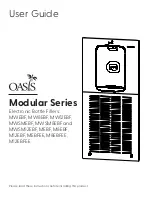
4 - The Solo Pure Water System Operation and Maintenance Manual
10. Maintenance
1. If using a pump, shut off the pump before turning off
supply water.
2. Close the shut off valve to the pole. Open bypass
valve to fully open position and flush out the system
for 3-5 minutes.
3. Turn supply water off.
4. Disconnect the water line. Make system water right
by connecting bypass hose to inlet and closing the
shut-off valve.
9. Shutdown
8. Soap Residue
Getting spotting when your TDS levels are below 10?
A common issue encountered when transitioning
buildings from traditional window cleaning methods
to pure water cleaning is soap residue. After the initial
cleaning with pure water, small white or gray spots and
runs may be seen on the glass after drying. Most often
this is soap and or detergent residue left behind by
previous traditional cleanings and brought out of the
pores of the glass by the pure water cleaning process.
The soap can take up to 30 minutes to dissolve if it
has been baked on or pushed into seals and frames.
Soaking the glass 15-20 minutes before performing
a normal agitation and rinse cycle will remove soap
spotting. Repeat agitation and rinse if the spots persist.
Your Solo system requires little maintenance to
operate at peak performance. As stated above,
flushing the RO membrane and having sufficient
bypass flow is essential to achieving maximum RO
lifespan.
RO membranes have the potential to process 100,000
gallons of water when properly maintained. To test the
health of your RO membrane compare the TDS levels
of the source water to the level of pure water leaving
the system. For example, 100 TDS source water with
10 TDS leaving the system indicates 90% rejection.
When rejection rate climbs above required levels for
your cleaning application it is generally time to buy a
new system. Adding a DI filter after the system can
allow you to keep an older Solo system in service
longer.
7. Using A WaterFed Pole
®
Once your Solo system is hooked up, and you have a
WaterFed® pole connected to the unit, you’re ready to
clean windows.
Always begin by cleaning the top row or highest
windows first, including scrubbing the frames. Work
the WaterFed® pole up one side of the frames, across
the top, and back down the other side. Scrub the glass
in an up and down motion, moving the pole the entire
length of the glass with each stroke if possible. Return
the pole to the top of the window, and with a side to
side motion, allow rinse water to flow completely down
the surface of the glass.
Frame rinsing may not be required. If the height of the
glass and the weight of the pole allow for it, hold the
brush slightly off of the surface of the glass to rinse. If
this is not possible, move the pole side to side slowly
with the brush on the glass at the top, and let the water
flow down the glass to rinse.
Once you have completed the top row or highest glass
on one side of the building, repeat these steps for each
tier or level of glass, working your way down. A good
initial scrubbing on the glass followed by a complete
rinse will ensure that the glass dries completely spot-
free.
Pure water is a great natural solvent for many soils.
In some cases, such as heavy soils, a pre-soak or
even a double scrub and rinse may be needed to
achieve optimal results. The agitation of the brush,
coupled with the flow of water through the brush when
scrubbing, should break down and suspend most soils,
readying them for complete removal via the rinse step.
As with any new procedure, practicing the use of your
WaterFed® pole is the best way to achieve optimal
results. Learn more about basic technique at
www. abcWindowSupply.com/StartingWF

























